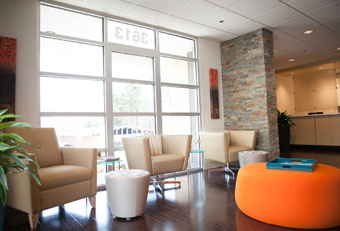Tubal ligation, also known as “having your tubes tied,” is one of the most effective, long-lasting forms of contraception. When women make the life-changing decision to have a tubal ligation, they want to prevent future pregnancies.

The good news is that a tubal reversal may pave the way for future children. If you’ve had your tubes tied and now want a child, you may be a candidate for this procedure.
Here’s a look at everything you need to know about tubal reversal.
The Right to Change Your Mind
Women choose tubal ligation for a variety of reasons. Many women decide they do not want more children and choose this procedure as a permanent solution.
If you’re regretting your decision to have a tubal ligation, you aren’t alone. Many women find themselves in the same situation.
What you once thought was the best decision for your life is no longer what you want. Life changes. Circumstances change. Partners change.
If you’re hoping to have a baby or add another child to the family, there is hope. A tubal ligation reversal may be the answer. Women in their 20’s, 30’s, and 40’s have had healthy pregnancies following a tubal reversal procedure.
You have the right to change your mind and take control of your reproductive health. Talk to your doctor about your reproductive options before making any life-changing decisions.
Am I a Candidate for Tubal Reversal?
Not everyone is a candidate for a tubal ligation reversal. The goal is not only to reverse the initial procedure. It’s to achieve pregnancy or renew the option for pregnancy in the future.
Some tubal ligation procedures can be reversed, but others cannot. You’ll want to get the operative report of your tubal ligation from the clinic or hospital where you had your procedure.
The doctor will review your health history, operative report, and any available images to evaluate the potential for a successful reversal. The hope is to maximize the possibility for a future pregnancy while keeping your health and safety a primary concern.
The success of the procedure depends on many factors. The chance of a successful tubal ligation reversal is higher if you have a sizable portion of a healthy fallopian tube remaining.
Types of Tubal Ligation
Tubal ligation isn’t always permanent. In some cases, the procedure can be reversed.
One of the primary factors for determining if you’re a candidate for the procedure is the type of sterilization procedure you had initially.
There are several types of tubal ligation procedures.
Pomeroy Tubal Ligation
With this sterilization method, a woman’s fallopian tubes are pinched with a suture. The loop that forms is cut and the ends of the tube are cauterized. This method is often effective for a reversal.
Tubal Ring
With this procedure, a small band or ring is placed around the loop of the fallopian tube. The ring contracts and constricts the base of the loop.
This blocks the fallopian tube. Reversal is often successful if damage to the fallopian tube is minimal.
Tubal Clips
For this procedure, a hinged plastic clip with a spring lock is placed across the muscular or isthmus segment of the tube. As the clip compresses, the spring locks the clip along the tube.
The clip is only 7 mm in width, so there is usually minimal damage to the fallopian tube. The pregnancy success rate is over 70% one year after reversal surgery and continues to rise over time.
Bipolar Coagulation
This is the most popular form of female laparoscopic sterilization. With this method, the doctor cauterizes sections of the fallopian tube. Damage is typically minimal and reversal success is around 70%.
Fimbriectomy
This procedure involves removing part of the fallopian tube close to the ovary. This prevents the ovary from transferring eggs to the fallopian tubes.
To reverse the procedure, the doctor must open the fallopian tube and fold out the lining to enable egg capture. The success rate of reversal is low. IVF is the preferred option in these cases.
Salpingectomy
This procedure involves removing the fallopian tubes. This procedure is used with ectopic pregnancies, ovarian cancer, and as a contraception option. The reversal success rate is less than 10%.
Essure
With this procedure, the doctor places a nickel coil through the uterine cavity into the opening of the Fallopian tube. There’s a small chance for reversal following this procedure.
What to Expect With a Tubal Reversal
If you’re considering a tubal reversal, you should begin with a consultation with a specialist in reversal surgery. After considering a variety of factors, the doctor will determine if the procedure is appropriate for you.
Typically, you will have a CBC blood test about a week before surgery. The reversal procedure involves a 2 to 4-inch incision above the pubic hairline.
The doctor takes blocked sections of the fallopian tubes and connects them to healthy portions of the tubes. This allows a woman’s eggs to move from the ovaries and through the tubes to unite with sperm.
A tubal reversal doctor uses small, delicate tools designed for microsurgery. Using these types of tools creates minimal tissue trauma and reduces the chances of obvious scarring.
Tubal reversal is normally outpatient surgery. In most cases, you can go home the same day as your procedure. You will return the following day or within a few days for a postoperative evaluation.
Will I Get Pregnant
Tubal reversal is the only way to restore fertility following a tubal ligation. For the majority of patients, tubal reversal is a successful procedure.
When your fallopian tubes are open, your eggs can pass into the tubes and become fertilized. Many women enjoy healthy pregnancies following a successful reversal procedure.
You can restore your natural fertility. Many patients become pregnant within the first year of having reversal surgery.
If a successful pregnancy occurs, chances are you can have future healthy pregnancies as well. The success rates vary depending on the type of tubal ligation and a woman’s overall health.
If you have difficulty conceiving after tubal reversal, there are options, including IVF and surrogacy. Your fertility specialist can help you decide how long you should try for a natural pregnancy before exploring other options.
Costs of Tubal Ligation Reversal
Many tubal reversal doctors offer financing options to help patients afford a reversal procedure. In most cases, insurance will not cover this elective procedure, so a payment plan is very helpful.
In certain cases, your insurance may combine the procedure with another medically necessary procedure. In this situation, the facility and anesthesia fee may be covered.
Do not look for a cheap option for reversal surgery. Consider your health above all else. You want a board-certified physician in reproductive medicine to perform your reversal procedure.
Semen Analysis
It’s always a good idea for a male partner to have a semen analysis. If there’s a male-factor fertility problem, a tubal reversal may not result in pregnancy.
It’s important to know the true cause of any fertility problems. If there’s a problem with sperm count or some other issue, undergoing tubal reversal may not be the best decision.
It’s good to know if your partner has sufficient sperm to father a child. If the semen analysis is less than ideal, you should discuss all options with your doctor.
Before you have a tubal reversal, make sure you know if you and your partner are able to have children with a successful reversal.
About the Risks
Any surgery has risks. The risks involved with a tubal reversal are minimal.
With this procedure, the physician lifts the uterus from the abdomen. Your chances for major complications are low. Your vital organs are protected within the abdomen.
Good health habits and healthy body weight reduce the risks of complications and the operating time. The average tubal ligation reversal lasts 90-120 minutes.
Some possible risks of the procedure include:
- Bleeding
- Infection
- Complications from anesthesia
- Scarring of the fallopian tubes
- Ectopic pregnancy
An ectopic pregnancy can be a complication of tubal reversal surgery. In an ectopic pregnancy, the fertilized egg implants outside the uterus, often in a fallopian tube.
If you miss your period or think you may be pregnant, contact your doctor right away. If you experience an ectopic pregnancy, prompt medical attention can preserve the tube.
Tubal ligation can also be performed through laparoscopy. This procedure involves a camera and some tiny incisions on your stomach. In some cases, a robotic device may be used for the procedure.
Patient recovery time is faster with laparoscopy. However, a laparoscopic procedure prolongs the surgery time and increases the cost of the procedure.
Successful Tubal Ligation Reversal
The success rates for pregnancy after tubal reversal vary based on the woman’s age and overall health. The procedure is commonly performed on younger women.
Some older patients who are not candidates for hormonal stimulation aren’t good candidates for IVF. In these cases, a tubal reversal may be their best hope for a child.
A successful reversal allows couples to try for a child in the months or years to come. IVF provides one opportunity for conception per cycle.
The success rate per IVF attempt is higher, but tubal reversal allows many opportunities for a pregnancy to occur. Talk to your doctor about your options, including adding fertility treatments such as intrauterine insemination and ovarian stimulation.
Every situation is unique. Factors such as maternal age and the type of tubal ligation you had play a major role in overall success.
It’s impossible to guarantee a successful pregnancy after a reversal procedure. Typically, younger women, 35 and under, have greater success rates.
However, more women in their 40’s are having healthy pregnancies than ever before.
How to Prepare for Surgery
Before you have tubal reversal surgery your doctor will discuss the risks and benefits of the procedure. Your doctor may discuss the following:
- The details of the procedure
- The likelihood of a successful procedure
- Your chances of pregnancy
- Potential side effects
- Other options for pregnancy, including IVF
Although any invasive surgery carries risk, tubal reversal is a common procedure and the risks of injury are low.
After the Procedure
Although a tubal ligation reversal is often an outpatient procedure, it’s important to take it easy 7-10 days after surgery. As soon as you feel strong enough, you can slowly resume your everyday activities and return to work.
Attend follow-up appointments with your doctor to make sure you’re healing properly. Be patient with your body and wait until you’re fully healed to try to conceive.
Talk to your doctor about when you should try to get pregnant and the best fertility strategies for you.
Choosing Your Doctor
If you’re considering tubal ligation reversal, it’s important to find an experienced tubal reversal doctor. You want to be confident in your doctor’s expertise with the procedure.
Your doctor should be transparent about the risks and benefits of the procedure. You should know all the costs upfront and understand any financing options to help you pay for the procedure.
Having Your Tubes Untied
Life circumstances change. It’s not unusual for women to seek tubal reversal. The goal of the procedure is a healthy pregnancy or the possibility of a healthy pregnancy in the future.
If you choose to have your tubal reversal performed at A Personal Choice, we will do all we can to ensure your procedure is safe, comfortable, and successful.
We know you may have questions about the procedure, and we’re here to help. Contact us today to schedule a consultation.









